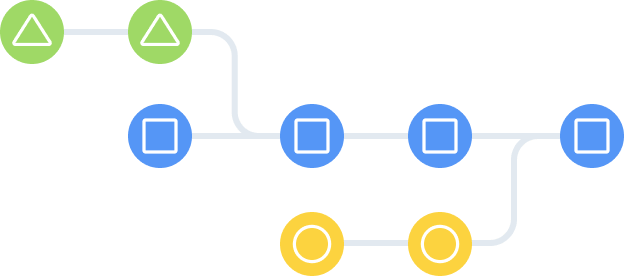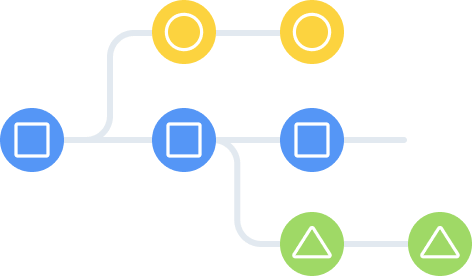Countdown mobile app
You will practice collecting user input, sending scheduled push notifications, sharing data between screens, and working with a database.




Bridge the gap between theory and real-world code by working on curated Swift projects. Use DevProjects as practice or enhance your portfolio with these fun Swift project ideas. From beginner Swift projects to more advanced ones, find your next coding project now.
You will practice collecting user input, sending scheduled push notifications, sharing data between screens, and working with a database.
You’ll create a simple, useful app to remind users to take breaks by customizing the time and length of their breaks. Get regular break reminders through push notifications. Depending on your experience, this project may take 8 to 16 hours.
You’ll create a mobile app to log the user’s mood, what they’re doing, and who they’re with at regular intervals throughout the day. The app will help users learn more about their typical and fluctuating moods. Depending on your experience, this project may take 12 to 20 hours.
You will create a to-do list application by using your preferred mobile application development framework. People are finding it harder and harder to remember and manage daily tasks in this fast-paced world. By creating a to-do list app, users can create and manage their daily tasks more easily.
Taking out loans and calculating monthly EMI can be confusing and stressful. However, with the help of a mortgage calculator, anyone can easily plan their mortgages out. You will build a mortgage calculator in this project!
Whether it's smartphones, cars, or speakers, voice assistants are becoming more and more integral to our everyday lives. Not only so, voice assistants are gaining traction in companies to help streamline operations like Customer Service. In this project, you'll build a full-fledged Joke Telling Robot Mobile App using Text to Speech APIs, which can be applied to both web apps and mobile apps.
In today's world, design is everything. Choosing the right color palette for your mobile app will help evoke different emotions you'd like your audience to experience. You'll build a full-fledged random color palette generator mobile app using Colormind API, which can be used for both web apps and mobile apps.
Irregular sleeping patterns are a common problem. This mobile app will fulfill the user's needs in tracking their sleeping patterns, including duration and timings. This app will track three parameters: sleep time, wake up time, and sleep duration. Users can add, edit, or remove any sleep entries.
You’ll create a mobile app with a swiping mechanism similar to dating apps like Tinder. Users can swipe left (dislike) or swipe right (like) on images downloaded from the Unsplash API. Through this project, you will learn both the programmatic approach and Storyboard approach to build mobile applications. You will also learn to achieve modularity and reusability with your code.
You will create a mobile application using your preferred technology. Users can authenticate, upload photos from their phone, view other peoples' photos, and vote on each photo. The estimated time for this project is around 25 hours.
You'll build a wallpaper app for mobile devices that consumes the Unsplash API! Depending on your experience, this project might take between 15 to 20 hours.
You'll build a mobile app to consume the News API and display a list of news articles. Clicking one of the news articles will open the news article within the app.
You'll build a mobile app to consume the Google Maps API and use Firebase, and build a social restaurants app for mobile devices.
You'll build a mobile app to consume the Eventbrite API that lets users discover & sign up for events! Depending on your experience, this project might take between 30 to 40 hours.
Subscribe to get notified when new Swift projects are published.
Subscribe
 HTML/CSS projects
HTML/CSS projects JavaScript projects
JavaScript projects React projects
React projects Vue projects
Vue projects Angular projects
Angular projects Node.js projects
Node.js projects Python projects
Python projects Ruby projects
Ruby projects Java projects
Java projects PHP projects
PHP projects Swift projects
Swift projects React native projects
React native projectsMore coming soon...

Bridge the gap between learning and applying new skills through projects designed by senior developers.

Learn and grow together by asking questions and discussing projects, reviewing code, and giving feedback.

Share your project code to get feedback on code structure, technical decisions, tradeoffs you've made, and more.
Codementor is a community of 12,000+ developers who help each other grow through one-on-one mentorship.
Created by Apple in 2014, Swift was designed to replace Objective-C for Apple ecosystems. When Swift became open-source a year later, it skyrocketed and became one of the fastest-growing languages. It’s currently the dominant iOS coding language and is also used across MacOS, tvOS, and other Apple platforms. Swift is easy to learn, even for beginners that have limited programming knowledge. One of the main reasons why the iOS coding language is easy to learn is that the syntax is clean, intuitive, and concise. This means that, Swift vs Objective-C, less code is required for the same task to be performed when written in Swift. The shorter feedback loop also makes it easier to test, debug, and ship high quality code. So, should I learn Swift? If you want to develop mobile apps, then you should definitely learn Swift. But doesn’t Swift only apply to Apple platforms? Yes, but many companies prioritize iOS apps over Android apps. iOS apps are faster and easier to develop, they’re compatible across Apple devices, and Apple users are more inclined to subscribe to apps compared to Android users. As Swift is a key to the success for companies that develop mobile apps, it’s not hard to see why there’s a constant demand for Swift developers.
Project-based learning is a method of learning where you learn a skill through working on a project. This type of learning allows you to learn not only the theory, but also how to apply those skills. By building a Swift project, you'll practice the high-level logic of your code and project, and see how each individual line can impact your application. You will also gain problem-solving skills and how to fix it. With so many Swift projects available, finding an idea that interests you will make the learning process more fun and sustainable. When you finish building a project, you will have learned and practiced Swift techniques, gained problem solving skills, learned how to ask questions, and have a finished project to show off.
The best way to learn Swift is to practice Swift by building as many projects as possible. There are three factors you should consider when picking the right Swift project: your skill level, goals, and interest. You want to have a good idea of your skill level and choose Swift practice projects that are not too easy or too hard for you. If you work on Swift projects that are too easy, you won’t progress in your coding abilities. However, if you choose projects that are too difficult, you may get stuck, never finish the project, and feel discouraged. Therefore, you want to choose Swift projects that are just a little bit above your current skill level. Now, you also want to build Swift projects that not only allows you to practice Swift, but also lets you show off your skills on your portfolio. So think about the types of Swift projects you want to put on your portfolio and jobs you’re interested in as a developer. Think about what your long-term goals are and pick Swift projects that align with them. Lastly, you definitely want to choose Swift projects that you’re actually interested in and feel connected to. Learning by building Swift projects you’re interested in will help you stay motivated. You’ll also be more likely to want to go above and beyond to make your Swift project stand out in the crowd.
Swift projects are a great way for beginners to learn. Two major obstacles beginners face when learning Swift are not knowing why you’re learning Swift and losing motivation. By learning Swift through building projects, you will be able to overcome both hurdles. When you’re learning Swift, you may not know how to apply Swift theories in the real world. But when working on beginner Swift projects, you immediately learn how each line of code impacts your project. By giving theory context, you’ll understand how to apply theories and find more resources to complete your Swift project. These Swift projects for beginners can also help you build up your portfolio early on. Each Swift project you finish can be incorporated into your portfolio to demonstrate your new skills. Another issue that often comes up for beginners is losing motivation. However, when it comes to projects, you can pick a beginner Swift project that you’re interested in. Not only will you be more motivated when you work on something interesting, you’ll also want to continue to improve the project. As your Swift project comes together, the sense of accomplishment will give you the momentum to keep going, even when things get hard. Additionally, you’ll learn how to approach problems from multiple angles and teach yourself how to search for answers. The ability to problem-solve is arguably one of the most important skills a developer should have.